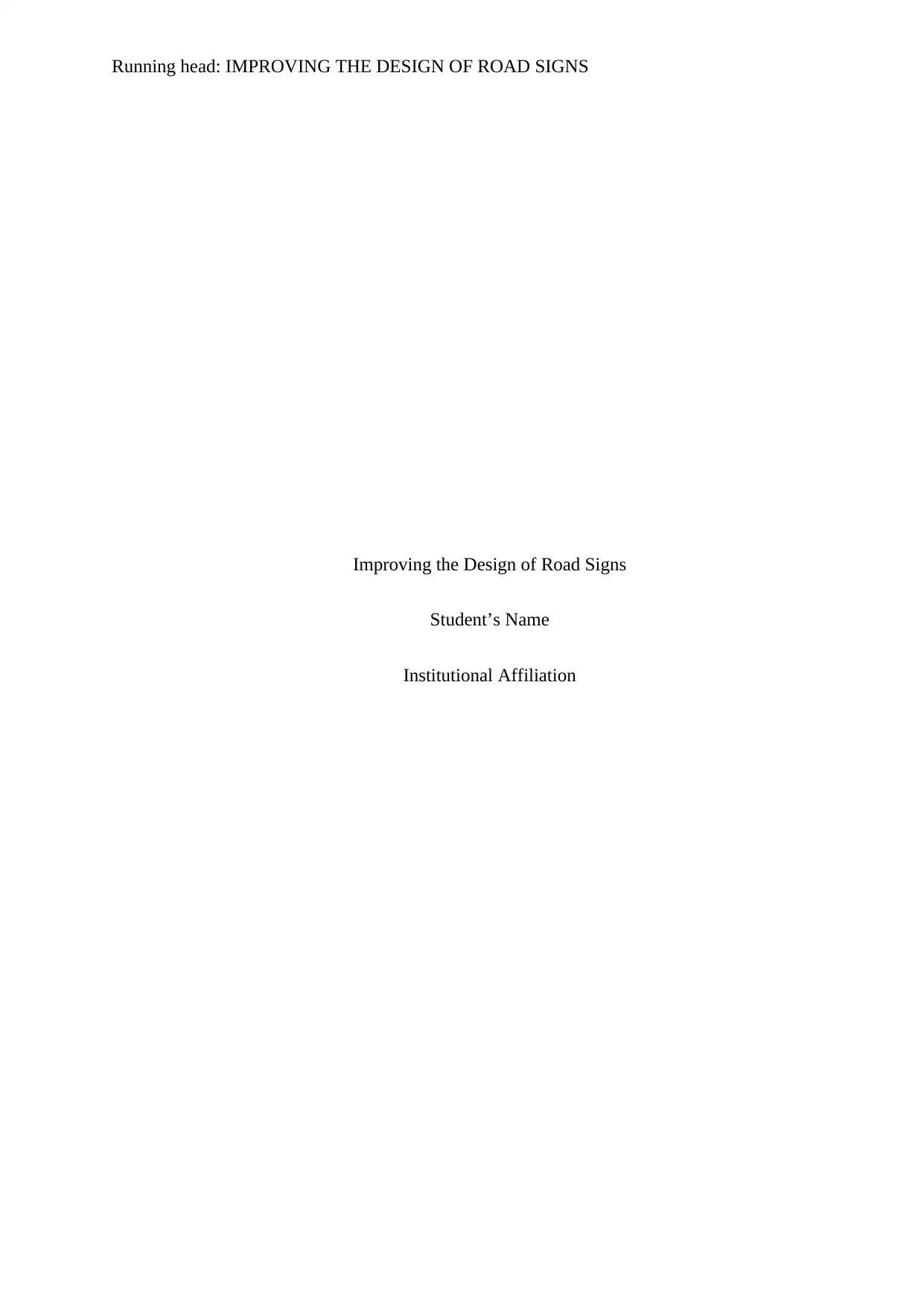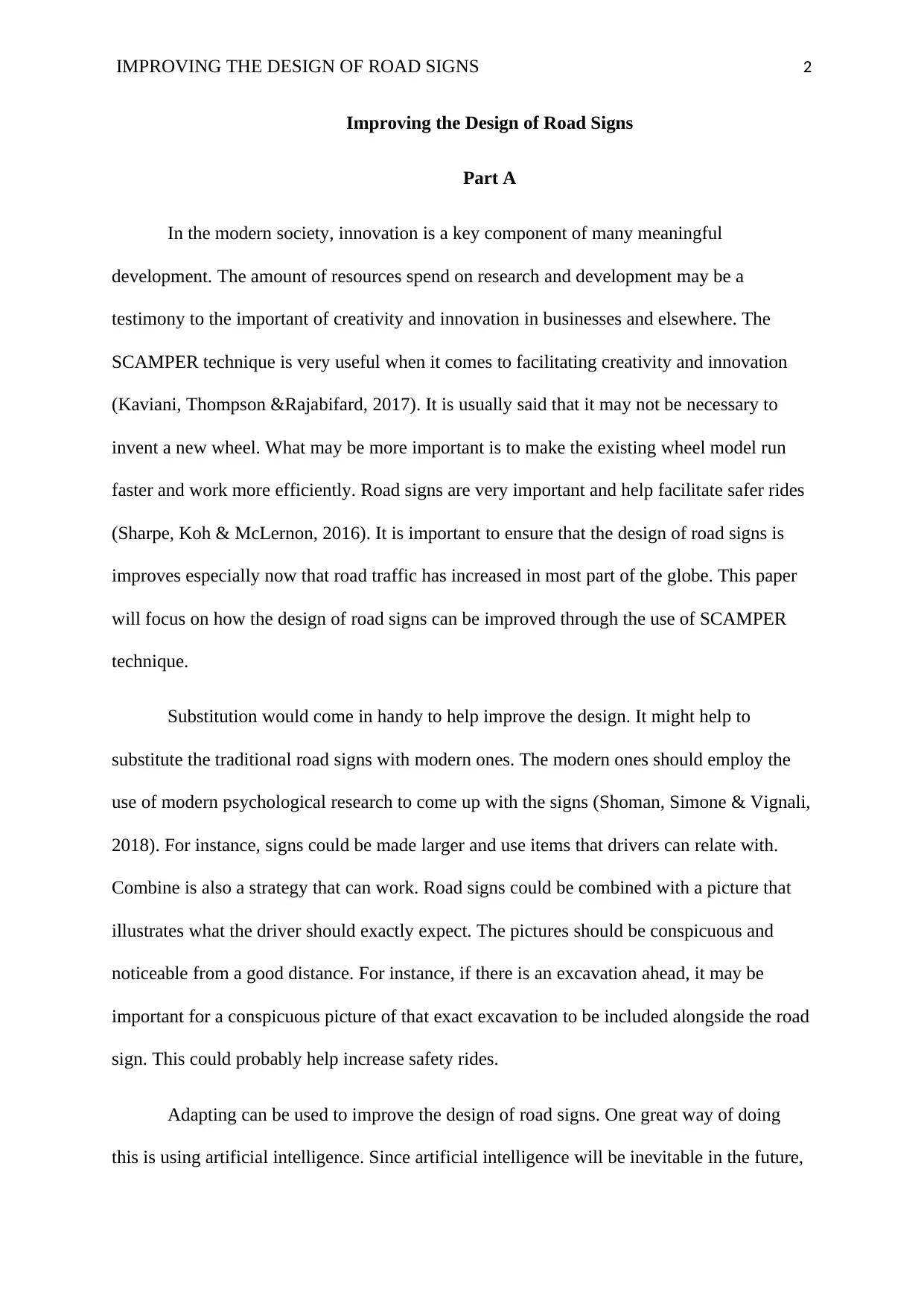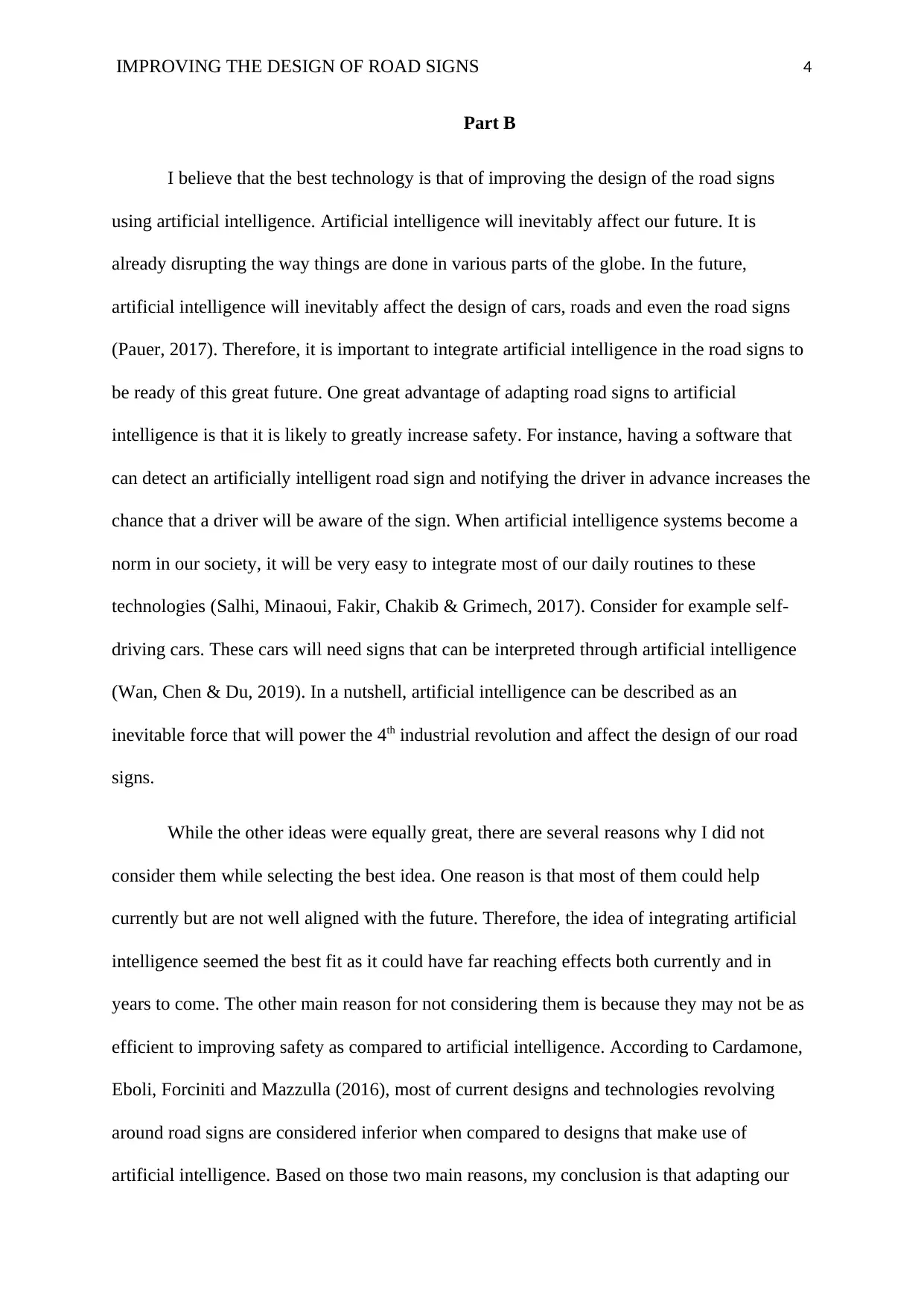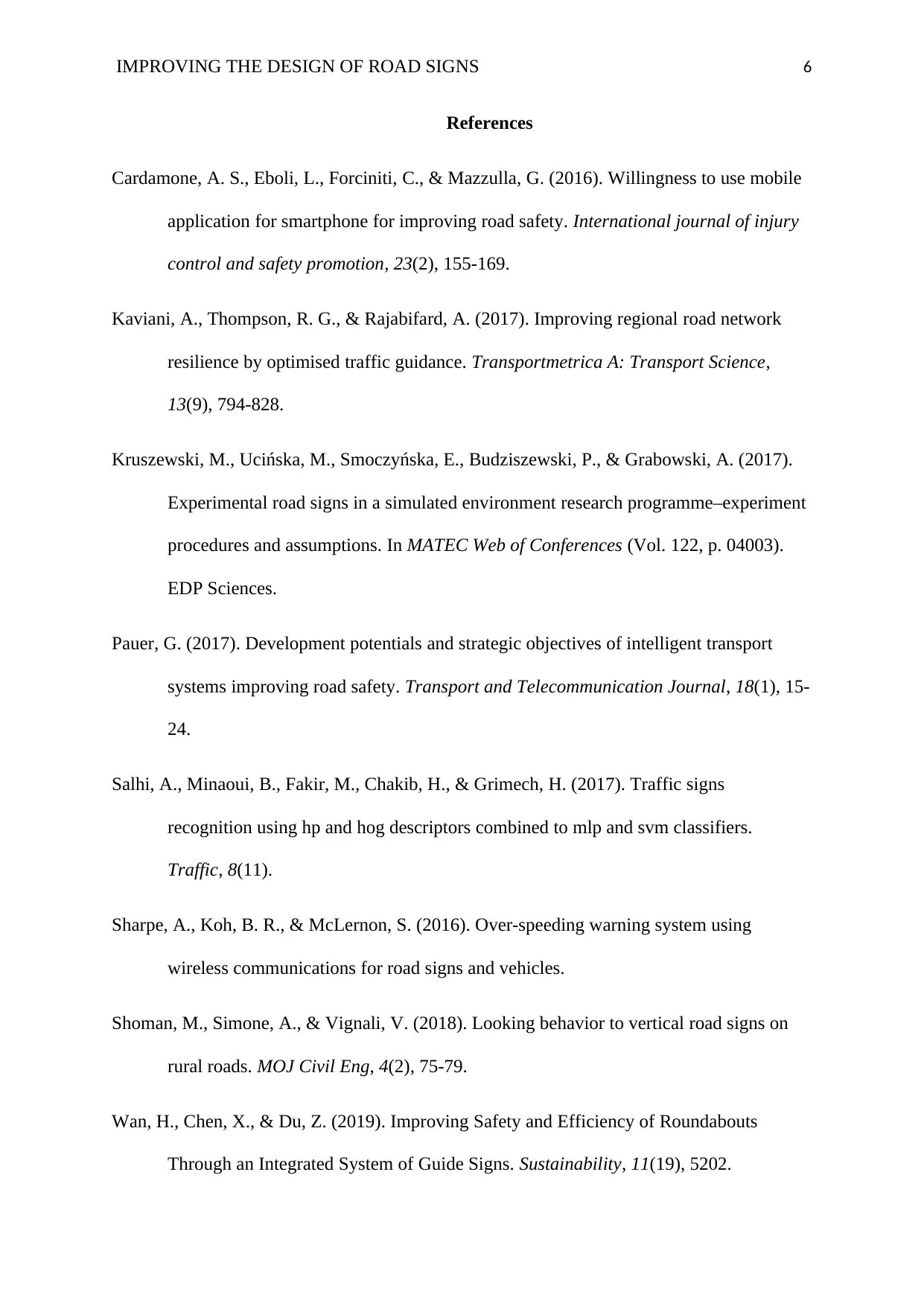Improving Road Sign Design Using SCAMPER Technique: Assignment 2
VerifiedAdded on 2022/08/08
|7
|1503
|27
Homework Assignment
AI Summary
This assignment explores the improvement of road sign design through the application of the SCAMPER technique, a creative problem-solving method. Part A of the assignment involves generating a variety of ideas for road sign enhancements using each letter of the SCAMPER acronym (Substitute, Combine, Adapt, Modify/Magnify, Put to other uses, Eliminate, Reverse). The student provides several innovative suggestions for each category, such as substituting traditional signs with modern ones informed by psychological research, combining signs with illustrative pictures, adapting signs with artificial intelligence, and modifying signs to include technology for driver compliance. Part B of the assignment then recommends the integration of artificial intelligence as the best approach, arguing that AI is aligned with future technological advancements and offers superior safety benefits compared to other ideas. The student supports this recommendation with references to relevant research and emphasizes the inevitable impact of AI on future transportation systems, including road signs and self-driving cars. The assignment concludes that AI integration is the most effective way to improve road sign design for the future.

Running head: IMPROVING THE DESIGN OF ROAD SIGNS
Improving the Design of Road Signs
Student’s Name
Institutional Affiliation
Improving the Design of Road Signs
Student’s Name
Institutional Affiliation
Paraphrase This Document
Need a fresh take? Get an instant paraphrase of this document with our AI Paraphraser

IMPROVING THE DESIGN OF ROAD SIGNS 2
Improving the Design of Road Signs
Part A
In the modern society, innovation is a key component of many meaningful
development. The amount of resources spend on research and development may be a
testimony to the important of creativity and innovation in businesses and elsewhere. The
SCAMPER technique is very useful when it comes to facilitating creativity and innovation
(Kaviani, Thompson &Rajabifard, 2017). It is usually said that it may not be necessary to
invent a new wheel. What may be more important is to make the existing wheel model run
faster and work more efficiently. Road signs are very important and help facilitate safer rides
(Sharpe, Koh & McLernon, 2016). It is important to ensure that the design of road signs is
improves especially now that road traffic has increased in most part of the globe. This paper
will focus on how the design of road signs can be improved through the use of SCAMPER
technique.
Substitution would come in handy to help improve the design. It might help to
substitute the traditional road signs with modern ones. The modern ones should employ the
use of modern psychological research to come up with the signs (Shoman, Simone & Vignali,
2018). For instance, signs could be made larger and use items that drivers can relate with.
Combine is also a strategy that can work. Road signs could be combined with a picture that
illustrates what the driver should exactly expect. The pictures should be conspicuous and
noticeable from a good distance. For instance, if there is an excavation ahead, it may be
important for a conspicuous picture of that exact excavation to be included alongside the road
sign. This could probably help increase safety rides.
Adapting can be used to improve the design of road signs. One great way of doing
this is using artificial intelligence. Since artificial intelligence will be inevitable in the future,
Improving the Design of Road Signs
Part A
In the modern society, innovation is a key component of many meaningful
development. The amount of resources spend on research and development may be a
testimony to the important of creativity and innovation in businesses and elsewhere. The
SCAMPER technique is very useful when it comes to facilitating creativity and innovation
(Kaviani, Thompson &Rajabifard, 2017). It is usually said that it may not be necessary to
invent a new wheel. What may be more important is to make the existing wheel model run
faster and work more efficiently. Road signs are very important and help facilitate safer rides
(Sharpe, Koh & McLernon, 2016). It is important to ensure that the design of road signs is
improves especially now that road traffic has increased in most part of the globe. This paper
will focus on how the design of road signs can be improved through the use of SCAMPER
technique.
Substitution would come in handy to help improve the design. It might help to
substitute the traditional road signs with modern ones. The modern ones should employ the
use of modern psychological research to come up with the signs (Shoman, Simone & Vignali,
2018). For instance, signs could be made larger and use items that drivers can relate with.
Combine is also a strategy that can work. Road signs could be combined with a picture that
illustrates what the driver should exactly expect. The pictures should be conspicuous and
noticeable from a good distance. For instance, if there is an excavation ahead, it may be
important for a conspicuous picture of that exact excavation to be included alongside the road
sign. This could probably help increase safety rides.
Adapting can be used to improve the design of road signs. One great way of doing
this is using artificial intelligence. Since artificial intelligence will be inevitable in the future,

IMPROVING THE DESIGN OF ROAD SIGNS 3
signs could be designed using this technology. After that is done, cars should be fitted with
software that can be able to read/ detect these signs and inform the driver on what to expect
or the course of action to take. It is without a doubt that such technology could greatly help
improve the design of road signs and help in reducing accidents.
Modifying/ magnifying generally refers to the art of altering a way in which things are
done presently. This technique may be used to improve road signs in several ways. One great
way to do that would be to include technology that ensures that the drivers are not only
alerted using road signs but also are made to comply through the use of technology. Let us
consider a pedestrian crossing for example. While it may be important to have a sign
illustrating pedestrian crossing, technology could be used to create a physical barrier when it
is time for pedestrians to cross. Therefore, such smart technology would enhance the design
by ensuring that drivers comply.
Putting to another use can be very important in improving the design of road signs.
For instance, traffic lights could also be fitted with speech processing tools so that they
inform the pedestrians and even drivers of what is expected of them. It is possible that a
pedestrian may not be aware of what a certain light means. Such explanations would come in
handy. It may also be of help to the visually impaired. Eliminating may work through
withdrawing all signs that may no longer be relevant and instead use modern ones. Reverse
refers to carrying out some rearrangement. This could be done through using smart
technology to improve the positioning of road signs. For instance, signs could be placed using
billboards or smart screens that are positioned in such a way that they are directly in front of
the driver.
signs could be designed using this technology. After that is done, cars should be fitted with
software that can be able to read/ detect these signs and inform the driver on what to expect
or the course of action to take. It is without a doubt that such technology could greatly help
improve the design of road signs and help in reducing accidents.
Modifying/ magnifying generally refers to the art of altering a way in which things are
done presently. This technique may be used to improve road signs in several ways. One great
way to do that would be to include technology that ensures that the drivers are not only
alerted using road signs but also are made to comply through the use of technology. Let us
consider a pedestrian crossing for example. While it may be important to have a sign
illustrating pedestrian crossing, technology could be used to create a physical barrier when it
is time for pedestrians to cross. Therefore, such smart technology would enhance the design
by ensuring that drivers comply.
Putting to another use can be very important in improving the design of road signs.
For instance, traffic lights could also be fitted with speech processing tools so that they
inform the pedestrians and even drivers of what is expected of them. It is possible that a
pedestrian may not be aware of what a certain light means. Such explanations would come in
handy. It may also be of help to the visually impaired. Eliminating may work through
withdrawing all signs that may no longer be relevant and instead use modern ones. Reverse
refers to carrying out some rearrangement. This could be done through using smart
technology to improve the positioning of road signs. For instance, signs could be placed using
billboards or smart screens that are positioned in such a way that they are directly in front of
the driver.
⊘ This is a preview!⊘
Do you want full access?
Subscribe today to unlock all pages.

Trusted by 1+ million students worldwide

IMPROVING THE DESIGN OF ROAD SIGNS 4
Part B
I believe that the best technology is that of improving the design of the road signs
using artificial intelligence. Artificial intelligence will inevitably affect our future. It is
already disrupting the way things are done in various parts of the globe. In the future,
artificial intelligence will inevitably affect the design of cars, roads and even the road signs
(Pauer, 2017). Therefore, it is important to integrate artificial intelligence in the road signs to
be ready of this great future. One great advantage of adapting road signs to artificial
intelligence is that it is likely to greatly increase safety. For instance, having a software that
can detect an artificially intelligent road sign and notifying the driver in advance increases the
chance that a driver will be aware of the sign. When artificial intelligence systems become a
norm in our society, it will be very easy to integrate most of our daily routines to these
technologies (Salhi, Minaoui, Fakir, Chakib & Grimech, 2017). Consider for example self-
driving cars. These cars will need signs that can be interpreted through artificial intelligence
(Wan, Chen & Du, 2019). In a nutshell, artificial intelligence can be described as an
inevitable force that will power the 4th industrial revolution and affect the design of our road
signs.
While the other ideas were equally great, there are several reasons why I did not
consider them while selecting the best idea. One reason is that most of them could help
currently but are not well aligned with the future. Therefore, the idea of integrating artificial
intelligence seemed the best fit as it could have far reaching effects both currently and in
years to come. The other main reason for not considering them is because they may not be as
efficient to improving safety as compared to artificial intelligence. According to Cardamone,
Eboli, Forciniti and Mazzulla (2016), most of current designs and technologies revolving
around road signs are considered inferior when compared to designs that make use of
artificial intelligence. Based on those two main reasons, my conclusion is that adapting our
Part B
I believe that the best technology is that of improving the design of the road signs
using artificial intelligence. Artificial intelligence will inevitably affect our future. It is
already disrupting the way things are done in various parts of the globe. In the future,
artificial intelligence will inevitably affect the design of cars, roads and even the road signs
(Pauer, 2017). Therefore, it is important to integrate artificial intelligence in the road signs to
be ready of this great future. One great advantage of adapting road signs to artificial
intelligence is that it is likely to greatly increase safety. For instance, having a software that
can detect an artificially intelligent road sign and notifying the driver in advance increases the
chance that a driver will be aware of the sign. When artificial intelligence systems become a
norm in our society, it will be very easy to integrate most of our daily routines to these
technologies (Salhi, Minaoui, Fakir, Chakib & Grimech, 2017). Consider for example self-
driving cars. These cars will need signs that can be interpreted through artificial intelligence
(Wan, Chen & Du, 2019). In a nutshell, artificial intelligence can be described as an
inevitable force that will power the 4th industrial revolution and affect the design of our road
signs.
While the other ideas were equally great, there are several reasons why I did not
consider them while selecting the best idea. One reason is that most of them could help
currently but are not well aligned with the future. Therefore, the idea of integrating artificial
intelligence seemed the best fit as it could have far reaching effects both currently and in
years to come. The other main reason for not considering them is because they may not be as
efficient to improving safety as compared to artificial intelligence. According to Cardamone,
Eboli, Forciniti and Mazzulla (2016), most of current designs and technologies revolving
around road signs are considered inferior when compared to designs that make use of
artificial intelligence. Based on those two main reasons, my conclusion is that adapting our
Paraphrase This Document
Need a fresh take? Get an instant paraphrase of this document with our AI Paraphraser

IMPROVING THE DESIGN OF ROAD SIGNS 5
road signs to artificial intelligence systems is the best way to improve the design of our road
signs. Extensive evidence reveals that effects of artificial intelligence will be overwhelming
just a decade from now (Kruszewski, Ucińska, Smoczyńska, Budziszewski & Grabowski,
2017). It is therefore wise to align our road signs to conform to this latest technology.
road signs to artificial intelligence systems is the best way to improve the design of our road
signs. Extensive evidence reveals that effects of artificial intelligence will be overwhelming
just a decade from now (Kruszewski, Ucińska, Smoczyńska, Budziszewski & Grabowski,
2017). It is therefore wise to align our road signs to conform to this latest technology.

IMPROVING THE DESIGN OF ROAD SIGNS 6
References
Cardamone, A. S., Eboli, L., Forciniti, C., & Mazzulla, G. (2016). Willingness to use mobile
application for smartphone for improving road safety. International journal of injury
control and safety promotion, 23(2), 155-169.
Kaviani, A., Thompson, R. G., & Rajabifard, A. (2017). Improving regional road network
resilience by optimised traffic guidance. Transportmetrica A: Transport Science,
13(9), 794-828.
Kruszewski, M., Ucińska, M., Smoczyńska, E., Budziszewski, P., & Grabowski, A. (2017).
Experimental road signs in a simulated environment research programme–experiment
procedures and assumptions. In MATEC Web of Conferences (Vol. 122, p. 04003).
EDP Sciences.
Pauer, G. (2017). Development potentials and strategic objectives of intelligent transport
systems improving road safety. Transport and Telecommunication Journal, 18(1), 15-
24.
Salhi, A., Minaoui, B., Fakir, M., Chakib, H., & Grimech, H. (2017). Traffic signs
recognition using hp and hog descriptors combined to mlp and svm classifiers.
Traffic, 8(11).
Sharpe, A., Koh, B. R., & McLernon, S. (2016). Over-speeding warning system using
wireless communications for road signs and vehicles.
Shoman, M., Simone, A., & Vignali, V. (2018). Looking behavior to vertical road signs on
rural roads. MOJ Civil Eng, 4(2), 75-79.
Wan, H., Chen, X., & Du, Z. (2019). Improving Safety and Efficiency of Roundabouts
Through an Integrated System of Guide Signs. Sustainability, 11(19), 5202.
References
Cardamone, A. S., Eboli, L., Forciniti, C., & Mazzulla, G. (2016). Willingness to use mobile
application for smartphone for improving road safety. International journal of injury
control and safety promotion, 23(2), 155-169.
Kaviani, A., Thompson, R. G., & Rajabifard, A. (2017). Improving regional road network
resilience by optimised traffic guidance. Transportmetrica A: Transport Science,
13(9), 794-828.
Kruszewski, M., Ucińska, M., Smoczyńska, E., Budziszewski, P., & Grabowski, A. (2017).
Experimental road signs in a simulated environment research programme–experiment
procedures and assumptions. In MATEC Web of Conferences (Vol. 122, p. 04003).
EDP Sciences.
Pauer, G. (2017). Development potentials and strategic objectives of intelligent transport
systems improving road safety. Transport and Telecommunication Journal, 18(1), 15-
24.
Salhi, A., Minaoui, B., Fakir, M., Chakib, H., & Grimech, H. (2017). Traffic signs
recognition using hp and hog descriptors combined to mlp and svm classifiers.
Traffic, 8(11).
Sharpe, A., Koh, B. R., & McLernon, S. (2016). Over-speeding warning system using
wireless communications for road signs and vehicles.
Shoman, M., Simone, A., & Vignali, V. (2018). Looking behavior to vertical road signs on
rural roads. MOJ Civil Eng, 4(2), 75-79.
Wan, H., Chen, X., & Du, Z. (2019). Improving Safety and Efficiency of Roundabouts
Through an Integrated System of Guide Signs. Sustainability, 11(19), 5202.
⊘ This is a preview!⊘
Do you want full access?
Subscribe today to unlock all pages.

Trusted by 1+ million students worldwide

IMPROVING THE DESIGN OF ROAD SIGNS 7
1 out of 7
Your All-in-One AI-Powered Toolkit for Academic Success.
+13062052269
info@desklib.com
Available 24*7 on WhatsApp / Email
![[object Object]](/_next/static/media/star-bottom.7253800d.svg)
Unlock your academic potential
Copyright © 2020–2025 A2Z Services. All Rights Reserved. Developed and managed by ZUCOL.